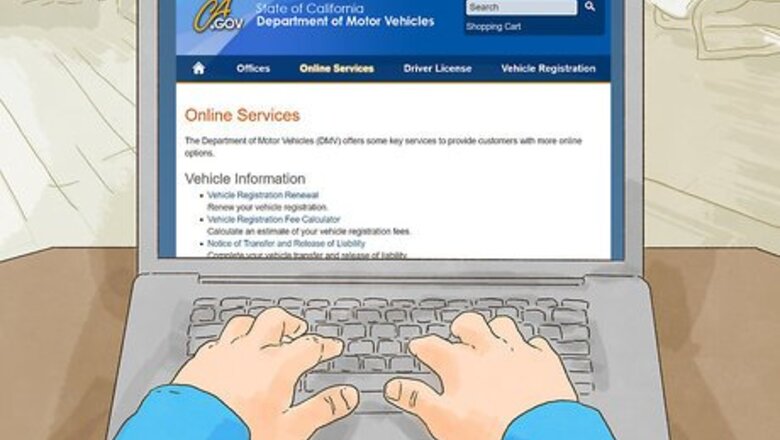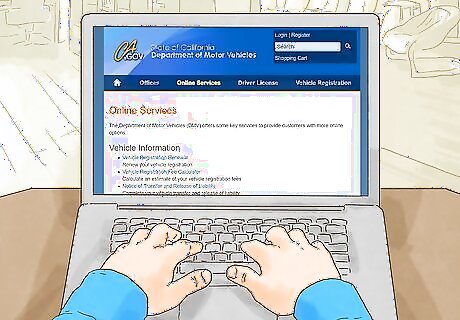
views
Titling Your Vehicle

Check a DMV website for the requirements in your state. The information you will need to get your vehicle titled varies from state to state. The federal government’s Department of Motor Vehicles website provides the specific information for each state on their website. You can also go directly to your state’s DMV website. Here you’ll find downloadable paperwork, as well as helpful phone numbers and addresses for offices you may need to visit. Expect to fill out an application (to either transfer or replace a title), and have information such as the vehicle's VIN number, odometer reading, and a bill of sale.

Get in touch with the previous owner. If you have a car without a title, get in touch with the previous owner to determine whether they still have the title. Whenever a car changes ownership, the title should be transferred as well. If you are unable to get the title transferred, getting a new title will be more challenging.

Fill out the necessary paperwork together. The easiest way to get your vehicle title is by finding the previous owner and going over the necessary paperwork together. The paperwork will vary from state to state. If possible, visit a state office together with the vehicle to fill out all of the paperwork and complete the transfer process. Do not make changes to an existing title. The title holder will complete paperwork indicating transfer of ownership and you will be issued a new title. There cannot be an outstanding loan against a vehicle while transferring the title, unless the transfer is approved by the lender. The odometer reading (at time of transfer) and VIN numbers on the vehicle must match those in the paperwork.
Replacing a Lost Title

Determine that you do not have the title. A title is the legal proof that you own a particular vehicle. It is an important piece of paper that should be kept in a safe and secure area. Unless you are certain it is permanently lost or stolen, keep looking for it, as it is a time-consuming and relatively expensive process to have a title replaced. If you have your title but it has been damaged, bring it to your local Secretary of State or DMV office.

Establish your eligibility for a bonded title. If you do not have a title to prove your ownership of a vehicle and cannot contact the party that sold it to you, you will need to purchase a surety bond and apply for a bonded title through your state government. Check your state’s DMV website for the eligibility requirements for a bonded title in your state. These will usually include residence in the state where you hope to title the vehicle.

Provide all necessary paperwork. Give everything required to prove your eligibility to a state office, as directed by your state's DMV website. You will also need to pay a fee. Necessary paperwork will likely include a statement of fact regarding how you came into possession of the vehicle, any other evidence that indicates your ownership of the vehicle, a photo ID, and an application for a bonded title. Note that a vehicle that has legally been deemed abandoned, junked, or stolen, or is involved in a pending lawsuit will not be eligible for a new title.

Purchase a surety bond. If you meet eligibility requirements, the state will send you a letter that contains the amount of the bond you will need to purchase. This bond amount will be greater than the value of the vehicle itself. The amount is determined by the state based on the information contained in your paperwork. Bring the letter to an agency that is licensed to sell surety bonds in your state, such as an auto-insurance agency. Keep in mind that you do not have to pay the state or the insurance company the value of your vehicle. While there will be some fee involved with the purchase of the bond itself, the bond is simply a legal instrument that makes you financially responsible for ownership of the vehicle.

Apply for a bonded title from your state. Once you have purchased a bond, return to the secretary of state to complete the titling process. You will then need to register your car to drive it legally.
Registering Your Vehicle

Check a DMV website for registration requirements. Before visiting a local state office where you can register your vehicle, check your state’s DMV website to make sure you bring all of the necessary paperwork. While the specific process varies, the basic order of operation is similar in most states. The federal DMV website also has information about registration requirements in each U.S. state. Current registration is required in every U.S. state. While some states require you to update your registration annually, registration lasts longer in some states.

Download and fill out forms ahead of time. If you want to make sure you have everything ready before visiting the DMV, download all of the forms you’ll need directly from the DMV website. Print them and fill them out at home to make sure you have all of the necessary information. You can also find information about applicable fees and taxes. Be ready to pay these when you register your car.

Visit a local state office to complete registration. The names of these offices may differ. For instance, your state may have brick-and-mortar DMV offices, while other states provide these administrative services at Secretary of State offices. Department of Revenue and Motor Vehicle Division offices also exist in some states. Bring along your title, proof of insurance, and emission test results or smog check paperwork if these are required in your state. Note that many states use your vehicles VIN as the vehicle registration number.




















Comments
0 comment